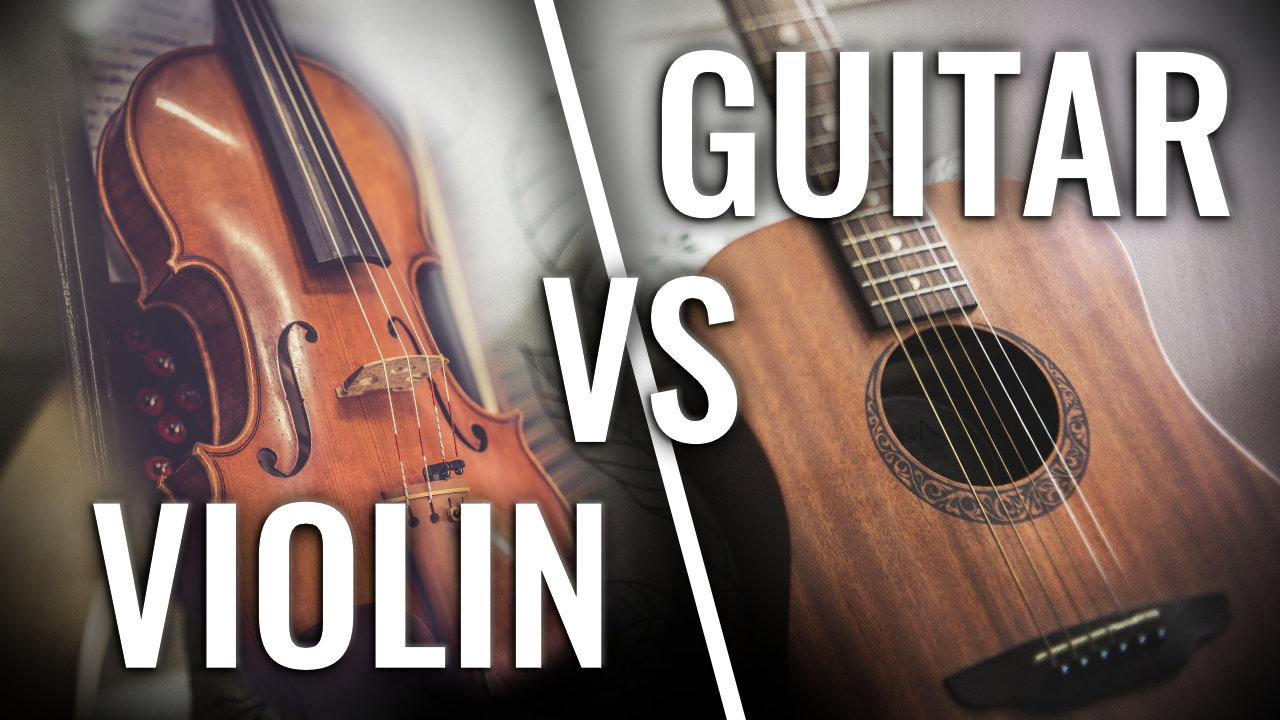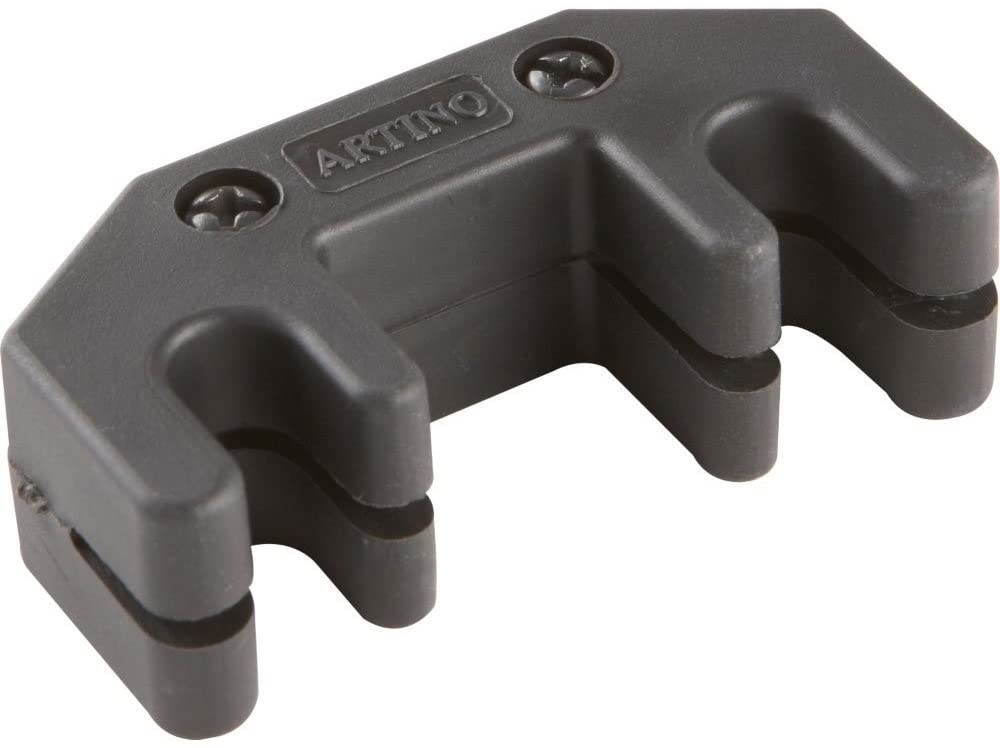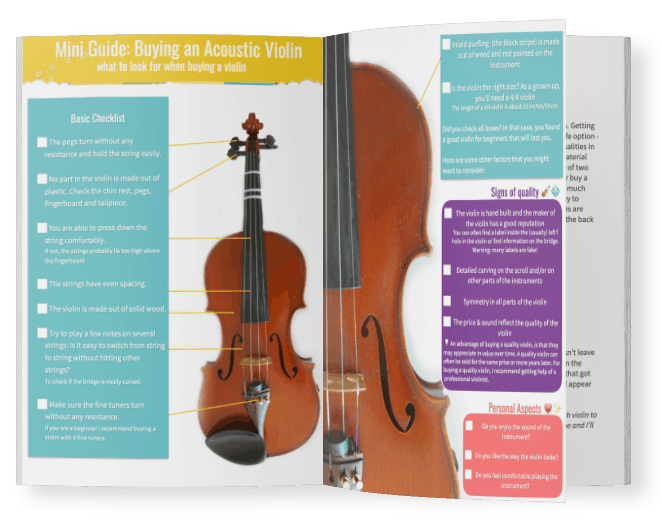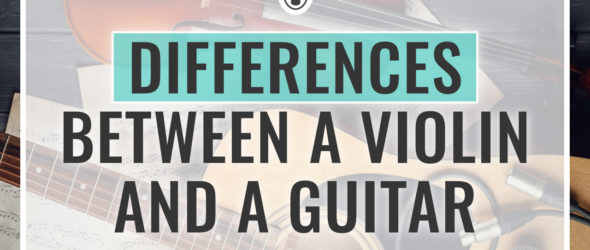What are the real differences between a guitar and a violin? And if you already play one of these two instruments, is it worth learning a second instrument?
I played both the violin and the guitar for over ten years. With this post, I want to shed some light on the differences between both instruments. Most of all, I want to share from the perspective of a player how the differences between violin and guitar can affect your experience playing both instruments.
If you are looking to start playing the guitar as a violin player, or the violin as a guitar player, or if you are just in doubt about which instrument to learn, this post is for you!
What is the Difference Between a Violin and a Guitar?
Let’s start with a quick answer to your most important question: what is the difference between a guitar and a violin? The most obvious difference is the look: violins are small and have four strings and a chinrest, while guitars are larger and have six strings. Violins are mostly used in classical music, while guitars are mostly used in pop and rock music. Both have a different structure, which creates a sound unique to each instrument.

12 Differences Between the Guitar and the Violin
Most of the readers of my blog are probably already aware of the differences shared above. That is why we will dive into a deeper, more detailed answer to the question below.
First, you need to know that guitars and violins can be divided into many different types. There are acoustic guitars, electric guitars, semi-acoustic guitars. There are many different types of violins too, such as electric, modern and baroque violins.
No matter what type of instrument you are comparing, some main differences apply no matter what specific type of guitar or violin you are comparing. I ordered these into four categories: structure, sound, playing style, and price.
Guitar vs Violin: Structural Differences
Let’s have a look at the structural differences! Because guitars and violins are uniquely designed, they each produce a different sound and require a different playing style. Let’s dive into the major differences between both!
1. A Violin Has 4 Strings, a Guitar has 6 Strings
The guitar has a total range of six strings (E-A-D-G-B-E) and the strings are usually thicker. The violin has four strings (G-D-A-E).
Because of the more rigid strings, it can be harder to keep the guitar strings down. This is especially the case when you are playing the guitar with steel strings. That is why many beginning guitar players struggle with pain in their fingers when they first start playing.
Violin players sometimes struggle with the same problems. However, this normally happens when practicing for many hours.

2. Guitars Only Have Pegs, Violin Also Use Fine Tuners
The tuning pegs of a guitar work differently than on a violin.
Guitars have one way to tune: the six tuning pegs, which are found on the head of the guitar. Each one of the pegs corresponds to one of the guitar strings.
The violin has a different tuning mechanism. On a violin, we use tuning pegs and fine tuners. You will need both to tune the violin. Turning a peg very slightly results in a big change in the pitch, so they are used when the strings are loose or very out of tune. The fine tuners are like the tuning pegs of the guitar and are used if the strings are only slightly out of tune.
If you turn the tuning pegs of the violin only a bit, there is a significant difference in sound. If you would do the same with guitar tuning pegs, the sound of the guitar only changes slightly.
Due to the sensitivity of the pegs and the way the fine tuners work vs. the guitar pegs, tuning the violin is quite a bit harder than tuning a guitar.
However, don’t be discouraged if tuning any instrument seems difficult to you! Even though it is challenging for inexperienced players, every musician will eventually master how to tune their instrument.
3. Guitars have a Fretboard, while Violins have a Fingerboard
The guitar fretboard and violin fingerboard are the long piece of wood that goes across the neck of a violin and a guitar.
The main difference between a fretboard and a fingerboard is hidden in the name itself. The fretboard has frets—these are pieces of metal on the fretboard. When playing the guitar, you use the gaps between the frets to place your fingers down on the strings.
On the violin fingerboard, there are no frets. You find the notes on the violin by pressing down the strings on the exact right locations. If you do not press the string on the correct location, the notes of the violin will sound out of tune.
The fact that the violin does not have a fretboard, makes the violin a lot harder to learn initially. While you can play the guitar on a decent level after about one year of practice, violinists often take a lot longer to start to sound good. That is why the violin is also considered one of the hardest instruments to learn.
4. Violins are Smaller than Guitars
A violin is a lot smaller than a guitar.
This makes it easier to bring on holidays, backpacking trips, or even transporting the violin to your violin lessons. The small size of the violin is one of the reasons that I practiced the violin a lot more, as I was easily able to take it with me when traveling (and I love adventure)!

If you play the guitar, there are also smaller travel guitars available. This can be a good option for those who wish to travel with a guitar. The downside of getting a travel guitar is that they usually do not sound as beautiful as a normal guitar.

Guitar vs Violin: Sound Differences
If you are looking to start to play either the guitar or the violin, one of the major reasons to choose either one of these instruments is the sound.
5. Violins Sound Louder Than Guitars

Violins sound a lot louder than guitars. That is why most violinists use a practice mute when they want to practice in the evenings. This is a small violin accessory that mutes the sound of the violin to a soft sound.
Plucking techniques on an acoustic guitar can sound soft. So, you can keep practicing the guitar at night without any extra accessories.
Of course, if you are looking to learn electric guitar and strumming techniques, a guitar will sound a lot louder!
6. The Range of a Violin is Bigger than a Guitar
On a violin, there are more notes you can play.
The range of a guitar is about 3.5 octaves, while the range of a violin is about four octaves. That means that you can play more notes on a violin.
In practice, there is extensive repertoire written for both instruments—and you will not find to be “missing” any notes as a guitar player.

The A major 4-octave scale is the highest and one of the most difficult scales to learn on the violin. It ranges all the way from the almost lowest to the highest note on the violin.
7. The dynamic differences are larger on a violin
It is being said that the violin is the instrument that comes closest to the human voice.
One of the reasons for that is that you can make a wide variety of sounds on the violin. The violin can both be played extremely softly and extremely loud. Many subtle differences can be made with the bow that can change the sound.
This is also one of the reasons that people tend to view the violin as one of the most emotional instruments.
The guitar can also make dynamic differences, but they are less extreme. The difference between playing soft and loud on a guitar is not just as large.
For instance, compare these two pieces written by Bach—one for solo violin, the other for a solo guitar (originally composed for a cello). You will notice that a guitar tends to sound calmer and a violin more intense, due to the dynamic differences.
Guitar vs Violin: Playing Style
8. On a guitar you are using a pick or your fingers, on the violin you are using a bow
Those who play the guitar know that there are two ways to create a sound on the guitar: with a pick and with your fingers.
On the violin, you are using a bow. Sometimes, violinists also pluck the strings—they will call it “playing pizzicato,” although it is not close to a commonly used technique on the guitar.
Here you can see an example of the song Street Spirit, which can both be played with a pick and with your fingers. This is also the first song I ever learned on the guitar! I used to be a massive fan of the band Radiohead, so of course, I could not wait to learn to play their songs as soon as I picked up the guitar.
9. The Guitar is a Chord Instrument, the Violin a Melody Instrument
Chord instruments are used to play chords (2 or more simultaneous notes), such as keyboard instruments (piano, keyboard, synthesizer), a guitar, or a harp. On these instruments, a bass part can be combined with chords and a melody.
A melody instrument, or sometimes the lead instrument, is the instrument, which plays the main melody of a piece. Usually, one note at a time is played.
One of the major differences between violins and guitars is that the violin is a melody instrument, while the guitar is a chord instrument.
Don’t get me wrong, both can play chords and single notes. The difference results from the anatomy:
- guitars, due to flat bridge, are meant to play chords
- violins with a curved bridge are designed to play single notes.
Most pieces for melody instruments are written for the solo instrument plus another chord instrument as an accompaniment. The chord instrument that most often accompanies violin players is the piano.
In a symphony or concerto, many melody instrument players come together to create both chords and melodies together. Orchestral music is music written for many types of melody instruments to play together.
Chord instruments normally have a lot more pieces written for them without any accompaniment. Think of the many guitar suites and instrumental music that are recorded without any accompaniment from other instruments.
Because the violin is a melody instrument, it is more versatile when it comes to playing together.
As a violinist, you can play in many different settings: orchestras, ensembles, bands, jam sessions. It is possible even without mastering the violin.
As a guitar player, you can easily play in bands, but it will be harder to find others to play classical music with, as you are not able to join an orchestra.
In general, I would consider the violin an inherently “social” instrument. A violin sounds nice on its own, but the true beauty of the violin comes out when playing together with others.
There are both positives and negatives to this fact.
I observed that it is a lot easier to find others to play with, as many social settings (jam sessions, orchestras, etc.) are looking for violinists.

On the other hand, it can be harder to make a beautiful sound just by yourself. There are fewer pieces written for solo violin.
Many violinists are using accompaniments in their practice sessions to make their pieces sound better.
On a guitar, you can more easily create a great sound by yourself. There is a vast array of pieces and song arrangements written for solo guitar players. Also, many guitar players accompany themselves while singing a song—creating a rich and full sound only using one instrument and the voice.
Players who love to play by themselves will probably enjoy playing the guitar. Those who love the social aspects of playing together will probably feel more inclined to learn the violin.
However, there are both violinists and guitarists who love to play together, and those who love to play by themselves. There is both a beautiful solo repertoire for the violin, as guitarists who are playing in band settings.
11. The Guitar Playing Position is More Comfortable
All people I know that play both guitar and violin unanimously agree that the playing position when playing the guitar is a lot more comfortable than on a violin.
The playing position on a violin is a little unnatural, as you are using your chin and shoulder to hold your instrument. Most violinists prefer to play standing up, although it is possible to sit down when playing too.
The playing position on a guitar is more natural. Most guitar players prefer to practice in the seated position.
Guitar vs Violin: Price
12. Violins are More Expensive than Guitars
Violins are more expensive than guitars. While you can get a great guitar for one thousand dollars, for violinists this price is still in the “beginner range.”
In recent years, many more affordable violins are entering the market.
If you plan to start practicing either the guitar or violin, I also recommend looking at second-hand websites in your local area. In this way, you can try out your new hobby without directly spending a fortune on your equipment.
Many people who quit playing the violin and the guitar are now selling their instruments. Most often, they also include all the accessories they used, which saves you a lot of time and money to get them!
If you are looking to buy a violin, I also recommend checking out my violin buyer’s guide in which I share the most important quality indicators to look for when shopping for both second-hand and new violins.

Violin Mini Guide [PDF]
GET IT NOW:
What is Similar in the Violin and the Guitar?
Even though the violin and the guitar have many differences, there are also many similarities when learning the violin and the guitar.
Violin and Guitar: Structural Similarities
Both violin and the guitar are string instruments. Even though the strings of the violin are played with a bow and the guitar is played with a pick or fingerpicking, the sound the instrument produces comes from the strings resonating in the body of the instrument.
Both musical instruments even have a similar tuning of the strings. For instance, the lower strings of the guitar are tuned: E – A – D – G (from low to high). The strings of the violin are tuned E – A – D – G (from high to low).
Violin and Guitar: Learning Similarities
It is no secret that as soon as you can play one musical instrument, it is easier to learn your second or third instrument.
The reason for that is that there are many similarities in studying different instruments, including when studying the violin and the guitar.
Even though when learning the guitar, you tend to be more focused on chords in the beginning and on the violin on solo pieces, many learning principles apply to both musical instruments.
For instance, note reading, rhythm, music theory, the notation of finger numbers above sheet music, and the practice strategies are similar on both the violin and the guitar.
Guitar vs Violin: Conclusion
I hope this article helped you with understanding the differences that you can expect when learning the guitar and violin.
If you have any more questions about learning the violin as a guitar player or the other way around, be sure to ask them in the comments. I might create follow-up articles on this topic if there is enough interest.
And, if you decide that learning the violin is right for you, be sure to bookmark this website! I upload weekly free violin lessons and tutorials that are perfect for anyone who is looking to learn the violin. Moreover, you are welcome to join my school—Julia’s Violin Academy—to learn how to play the violin with a step-by-step course and get to know other beginner violinists!
























